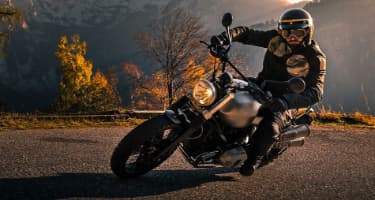Riding a motorcycle is a thrill that's hard to beat. From the freedom of the open road to the roar of the engine - motorcycle owners have plenty to boast about.
In Australia, more than 40,000 motorcycles were sold between January and June 2024, which shows just how keen Aussies are about their two-wheelers.[1]
And there are plenty of benefits from cheaper running costs to ease of parking - there's a lot to love.
So whether you're looking to shave time off your daily commute or enjoy long, cruising rides on the weekend, we've compiled a pros and cons list of different types of motorcycles to help kickstart your journey.
Standard Motorcycle

The standard motorcycle is the oldest motorcycle style and a true classic. Also known as a 'naked bike' or 'roadster,' they're perfect as a starter bike or for a daily commute.
The seating position is upright and neutral, and as the name suggests, they're designed to be more lightweight, having little to no fairings (panels) or added storage space.
Standard motorcycle engines can range between 125cc and 1000cc, and they're a great all-rounder. Good for fuel efficiency, manoeuvering through traffic congestion and they'll get you from A to B - and probably even to C.
Pros
- Lightweight and agile
- Perfect starter bike
- Option to upgrade to a sports standard for more power
Cons
- Not designed for long-haul comfort
- Little wind protection
- Minimal storage capacity
Cruiser Motorcycles

If you're after timeless style and a laid back riding position, then the cruiser motorcycle might be for you.
These are the types of motorcycles you'd find in a 1950s Hollywood tough-guy movie. Cruisers have an emphasis on style, often fitted with polished chrome panels and sleek fairings - they tend to attract attention wherever they go.
Cruisers can have larger engines, ranging from around 500cc to 2000cc. The seat is low, with the rider's position slightly inclined to the back, allowing for an upright but relaxed riding position. With cruisers, it's all about taking time to enjoy the ride.
American manufacturer Harley Davidson remains a popular choice for those after a cruiser model, winning the 2023 Canstar Review for best-rated motorcycle where it was voted five stars for style, comfort, reliability, technology features and overall satisfaction.[2]
Pros
- Highly customisable
- Classic/vintage style
- Comfortable seating posture
Cons
- Less fuel efficiency
- Heavyweight and can be unwieldy at low speeds
- Difficult to weave through traffic
Sport Bikes

Sport bikes are geared toward power and performance - made with a large engine and a lighter frame, they're designed to accelerate and hit top speeds quickly.
Everything about them is built for speed, from the aerodynamic panels to the low tread tyres to the aggressive riding posture which minimises wind resistance. A sports bike allows for side-to-side manoeuverability and agility.
If you’re after a thrill, then a sport bike will take you there. If you’re new to riding, however, these bikes can be challenging due to the high amount of horsepower and skill required for handling turns. It’s worth noting that learner drivers might not even be able to legally drive certain sport bikes as some motorcycle types aren’t allowed on a learner licence.
But that’s not to say sports bikes can’t be mastered with the correct training and safety measures. Many local race tracks offer recreational ride days where you can test out your bike’s capacity in a controlled environment.
Just make sure you have the appropriate safety gear, including a helmet, gloves, boots and a leather suit. You can also learn more about Budget Direct’s Motorcycle Insurance cover options to protect your ride.
Pros
- Speed and agility
- Lightweight
- Powerful engine
Cons
- Uncomfortable for long-distance rides
- Little to no storage capacity
- Potentially challenging for beginners
Touring Bikes

Touring bikes are the ultimate long-haul companion. Perfect for road trips with friends or out solo on the open road, riding for hours on end. Touring bikes will take you cross-country in comfort.
Built for long-distance, they come equipped with comfortable seats, often room for a rear passenger, good wind protection and plenty of storage capacity.
Touring motorcycles are designed to go that extra mile, optimised with add-ons that might include heated grips and seat warmers, navigational display features and Bluetooth connectivity. You can ride comfortably into new territory.
Pros
- Suitable for long distance rides
- Ample storage capacity
- Comfortable riding position
Cons
- Can be more expensive than other bikes
- Large and Heavyweight
- Less agile through tight spaces
Sport Touring Motorcycles

Sport touring motorcycles combine all the benefits of a touring bike and a sport bike. They're ideal for long-distance trips but optimised for speed and agility.
Sport touring bikes come with middle to large-range engines, designed for both long and short distance rides. The seating position is somewhere between a regular touring bike and a sport bike and they're fitted with aerodynamic panels.
Sport-touring motorcycles may sacrifice slightly on luggage capacity to stay lightweight, but they more than make up for it with the combination of speed and comfort - perfect for a long-haul adventure.
Pros
- Suitable for all riding lengths
- High-performance ability
- Comfortable
Cons
- Poor fuel efficiency
- Expensive to purchase and maintain
- Potentially too large and heavy for inner-city riding
Adventure Bikes

Adventure bikes are like the 4x4s of the two-wheeled world. Also known as dual-sport motorcycles, these bikes can handle almost any terrain you throw at them - from pavement to dirt tracks, to muddy plains and even water.
While adventure motorcycles are great on-road, they also fall into the off-road bikes category which also include dirt bikes and motocross bikes.
Dual-sport bikes are an offshoot of the early Enduro mountain bike, which is designed for cross-country endurance racing. An adventure bike has high-ground clearance, increased suspension and grippy, durable tyres.
Pros
- Great on-and off-road capabilities
- Excellent tyre grip
- Durable
Cons
- Too heavy for challenging trials
- Not enough power for high-speed riding
- Complex engines which can be difficult to repair in remote areas
Scooters

There are some key differences between a standard motorcycle and a scooter. There are also so many benefits that make scooters a worthy candidate in the two-wheeled world.
Scooters are light, easy to ride and relatively inexpensive to run. Scooters may be the ultimate urban companion, especially for those who are new to riding or looking for something easy to get to work or ride around town with.
The riding position on a scooter is relaxed and upright, usually with a step-through frame (and easy footrest) so they work well if you have difficulty mounting or dismounting traditional motorcycles.
In terms of engine capacity, they usually range between about 50cc-500cc, which is on the lower end of the scale in terms of power, but it's still certainly enough to get you from A to B on paved roads.
Scooters are perfect for zipping around town but are not really built for off-road riding or long distance trips.
Scooter Insurance is also available to cover you for loss or damage in an insured event. With Budget Direct, you can choose between multiple scooter insurance options to find a level of cover that suits your individual needs.
Pros
- Comfortable footrest
- Some have automatic transmission (no shifting gears)
- Inexpensive running costs
Cons
- Can be uncomfortable on long rides
- Not as powerful as a traditional motorcycle
- Slower than a traditional motorcycle or car
Electric Motorcycles, E-scooters and E-Bikes

There's no telling what the future holds when it comes to electric vehicles and popularity is certainly growing, as evidenced by the sheer number of them on the roads.
Electric motorcycles are hitting impressively high speeds on the track and the performance gap between petrol and electric is closing quickly.
In some states, Australians are even being offered government incentives for the purchase of e-scooters and e-bikes, as well as the installation of Electric Vehicle (EV) chargers, in a bid to reduce emissions.
Electric motorcycles are considered zero-emission vehicles as they do not produce exhaust pipe emissions. But that doesn't stop them from being incredibly powerful and reliable. Here are some factors to consider though, should you make the switch from petrol and diesel, over to electric:
Pros
- Savings on running costs
- Lower emissions
- Powerful acceleration
- Generally single-speed (no gear-shifting)
Cons
- Limited charge range
- Higher upfront costs
- Long charging times
- Manufacturing emissions remain high
Motorcycle Insurance

Motorcycle Insurance plays an important part in keeping your motorcycle safe; whether it's damaged, broken or beyond repair as a result of an insured event. The type of insurance policy you choose will determine how you are protected in case of an accident.
Before purchasing insurance, make sure you have a valid motorcycle licence, and if you're a beginner and yet to obtain one, you might want to check out our guide on how to get your motorbike licence.



.jpg)

